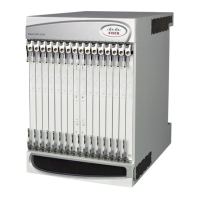Packet Data Interworking Function Overview
▄ Cisco ASR 5000 Series Product Overview
Alternately, the DMH can send both voice and data over WiFi when a local AP is available. When the DMH connects to
the AP, it establishes an IPSec tunnel over the broadband access network. This tunnel terminates at the PDIF/FA.
The DMH initially gets an IP address, also known as a Tunnel Inner Address (TIA), from the PDIF/FA when the DMH
establishes the first IPSec tunnel. The PDIF/FA assigns the TIA from its IP address pool. The DMH then starts mobile
IP through this initial TIA-based IPSec tunnel.
When the DMH successfully sets up mobile IP, it receives the home address from the HA. The DMH then establishes a
second IPSec tunnel using this HA. Once the DMH successfully establishes the second IPSec tunnel with the PDIF/FA,
the PDIF/FA tears down the first TIA-based IPSec tunnel to free the TIA, which then returns to the IP address pool. If
required, use the command in config-subscriber mode to prevent the TIA from returning to the
pool. The DMH sends packetized voice and data through the PDIF/FA to the HA through the second IPSec tunnel.
In this scenario, the PDIF/FA forwards all the packets between the DMH and the HA. From there, voice packets are
delivered to the Session Initiation Protocol (SIP) infrastructure, while data is delivered to the Internet or other
appropriate destinations.
Mobile IP / Native Simple IP Call Minimum Requirements
The following provides the minimum requirements for each call type:
Mobile IP Calls
The PDIF/FA assumes MIP tunnel establishment over IPSec tunnel as part of the PDIF call flow as soon as any one of
the following three possible conditions is met:
1. The default subscriber profile has configured, or:
2. The Radius VSA SN1-PDIF-MIP-Required is returned by AAA during user authentication, or,
3. The MS requests the MIP session type by injecting the IKEv2 configuration attribute 3GPP2_MIP4_MODE.
Native Simple IP Calls
The PDIF/FA assumes a native simple IP session over an IPSec tunnel if:
• The MS (DMH) does not request 3GPP2_MIP4_MODE in IKEv2 exchange, and:
• If a subscriber profile is defined, it does not have the pdif mobile-ip required parameter, and:
• The AAA server does not return the VSA SN1-PDIF-MIP-Required during MS user authentication.
Mobile IP Session Setup over IPSec
The following diagram and table describe the mobile IP session setup over IPSec.

